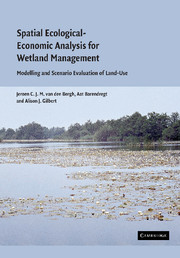 Spatial Ecological-Economic Analysis for Wetland Management
Spatial Ecological-Economic Analysis for Wetland Management Book contents
- Frontmatter
- Contents
- List of figures
- List of tables
- Preface
- 1 Introduction
- 2 Wetlands and science
- 3 Integrated modelling and assessment
- 4 Theoretical framework and method of integrated study
- 5 The Vecht area: history, problems and policy
- 6 Development scenarios for the Vecht area
- 7 The spatial–ecological model: hydrology and ecology
- 8 The spatial–economic model: agriculture, nature conservation and outdoor recreation
- 9 Performance indicators for the evaluation
- 10 Evaluation of the scenarios
- 11 Conclusions: policy and research implications
- References
- Index
11 - Conclusions: policy and research implications
Published online by Cambridge University Press: 24 November 2009
- Frontmatter
- Contents
- List of figures
- List of tables
- Preface
- 1 Introduction
- 2 Wetlands and science
- 3 Integrated modelling and assessment
- 4 Theoretical framework and method of integrated study
- 5 The Vecht area: history, problems and policy
- 6 Development scenarios for the Vecht area
- 7 The spatial–ecological model: hydrology and ecology
- 8 The spatial–economic model: agriculture, nature conservation and outdoor recreation
- 9 Performance indicators for the evaluation
- 10 Evaluation of the scenarios
- 11 Conclusions: policy and research implications
- References
- Index
Summary
Purpose
Wetland areas are under heavy pressure and require the attention of both natural and social scientists. In order to arrive at useful policy and management suggestions to ameliorate problems related to the human use of, and impacts on, wetlands, the integration of theories, models and indicators of relevant natural and social sciences is necessary. For this purpose, the present study as developed an integrated research method that combines hydrology, ecology and economics, using spatial modelling and evaluation techniques. This method was applied to the Vecht wetlands area (De Vechtstreek) in the centre of the Netherlands, an area of about 160km2 in size that includes natural and artificial lakes, reedbeds, fens, peatlands, marshes, forests and wet pasturelands. The area's land cover, land use and landscape are the product of an interaction between human activities and natural processes over centuries. The main activities are agriculture and recreation, while the main conflicts are between agriculture, on the one hand, and nature conservation and outdoor recreation, on the other hand. Much information is available for the area, via natural science studies performed in the past, as well as through local, regional and national policy documents.
Method of integrated research
The method of integrated study entailed the heuristic integration of hydrological quality and quantity modelling, vegetation response modelling and economic modelling and accounting.
Information
- Type
- Chapter
- Information
- Spatial Ecological-Economic Analysis for Wetland ManagementModelling and Scenario Evaluation of Land Use, pp. 207 - 213Publisher: Cambridge University PressPrint publication year: 2004